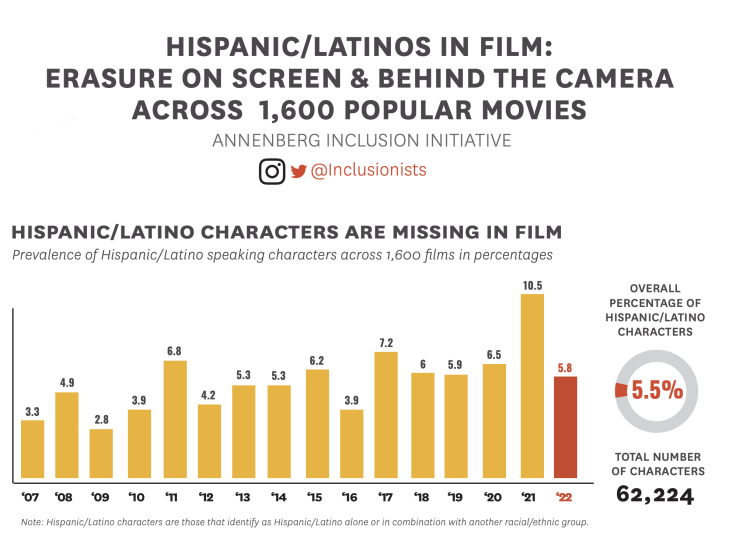
Out of 1,600 popular movies released between 2007 and 2022, only 5.5 percent of the characters were Hispanic or Latino. The figure comes from the University of Southern California's Annenberg Inclusion Initiative, which recently released a study titled "Hispanic/Latino Representation in Film: Erasure On Screen & Behind the Camera.
The study also found low numbers of Hispanic or Latino directors and producers. Concretely, in 2022 only 5.8 of movie characters were Hispanic or Latino. Similarly, the rate of Hispanic or Latino directors was low, with only 3.5 percent, while 3.3 percent of all producers belonged to this demographic. The figure contrasts with the overall Latino population in the U.S., which currently amounts to almost 20 percent of all people living in the country.
The study cited 2021 as the only year that saw more than 10 percent of movies including Hispanic or Latino actors, which they credited to a few big hits.
"Only in 2021, the year in which West Side Story, In the Heights, and Encanto were released, has the percentage of Hispanic or Latino characters exceeded 10 percent," said the study. "In an industry that purports to value inclusion, it is clear that being inclusive– even in the fictional worlds it purveys– still does not extend to representing Hispanic/Latinos in any measure approaching their proportion in the U.S. population."

When reviewing studios, the analysis showed that Warner Brothers produced the least number of films with leading Hispanic or Latino actors—three films, or 1.2 percent of the total sample. The studio that produced the most was Universal, with fifteen films or 5.7 percent.
How Many Lead Actors Were There?
Of the 1,600 films reviewed, only four percent of leading actors (75 overall) were Hispanic or Latino, 43 of them being women. Even less represented were Afro-Latinos, with only eight of them landing leading roles in those 1,600 movies.
What does the industry look like specifically for Latinas?
The rate of acting roles is slightly lower than men's. The study cites that in 2022 40.7 percent of Hispanic or Latino actors identified as female.
2022 saw zero Latina directors and only 4 Latino directors. The study showed that female directors from this demographic are very few, with only 5 out of 1,784 Hispanic or Latino directors —0.28 percent.
The study shows a similar story with Latina producers: only 11 were Hispanic or Latino, four of them women. From 2007 to 2022, only 34 out of 5,065 producers were Latina—0.67 percent.
Regarding casting directors, Latinas were somewhat more prominent in this area. Hispanics or Latinos made up 3.5 percent of casting directors, and of that 3.5 percent, 76.7 percent were Latinas.
How were Hispanics or Latinos Portrayed?
56 percent of Hispanics or Latinos were portrayed as criminals, 15 percent were portrayed as involved in organized crime and 46 percent were portrayed committing violent crimes.
From 2017 to 2018, 28 percent of Hispanic or Latino characters were portrayed as criminals, while the figure climbed to 57.8 percent in 2022. The data for Hispanic or Latino characters portrayed as violent criminals were similar, with 2019 data showing 40 percent portrayed as violent criminals and 2022 data showing 46.2 percent portrayed as violent criminals.
The amount of Hispanic or Latino characters portrayed as temperamental increased significantly in a five-year period. From 2017 to 2018, 21 percent of characters were portrayed as temperamental, but the figure increased to 40 percent in 2022.
The percentage of Hispanic or Latino characters portrayed as immigrants also increased in that period. From 2017 to 2018 it was five percent, increasing to 24.2 percent in 2022.
Of the top-billed Hispanic or Latino actors, 47 percent were portrayed as religious. Interestingly, this increased exponentially, with the study citing that from 2017 to 2018, 26 percent of Hispanic or Latino characters were portrayed as religious.
© 2025 Latin Times. All rights reserved. Do not reproduce without permission.





